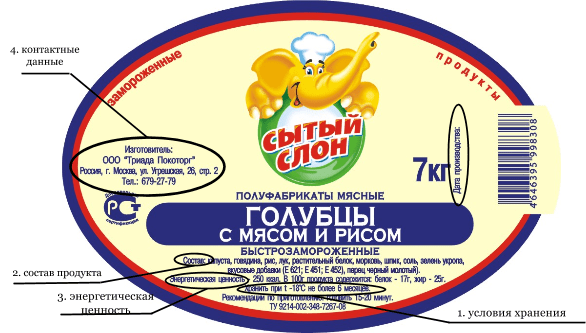
How to read food labels?
Content
Want to shop smarter and healthier? If so, learn to read food labels! Although it may seem difficult at first, you will quickly develop this habit and with each subsequent purchase you will look at the shelves with the eyes of an expert.
Consumer awareness is growing every year. We are no longer satisfied with the good taste of what we eat. We want to know what ingredients food is made of and whether they are really good for our health. For this reason, we look at labels more often. However, it's easy to get frustrated when the list of ingredients seems endless and foreign-sounding names mean nothing to us. But all you need to know is a few helpful tips to help you decipher even the most difficult labels. Over time, reading them will become your bloodstream and will not be difficult. It's worth spending a little time learning so you don't get stuck in the proverbial bottle. So let's get started?
Short and long composition
There is a lot of truth in the belief that the shorter the ingredient list, the better. A longer formulation risks having more room for unhealthy additives and food being heavily processed. Remember that good quality foods don't need flavor enhancers or thickeners. However, it happens that the composition is long due, for example, to useful herbs and spices. In this case, the label is all right.
Pay attention to the order
Perhaps few people know that the order of the ingredients on the label is not accidental. Manufacturers list them in descending order. This means that what comes first in a product is the most important. This rule applies accordingly to all subsequent ingredients. So if, for example, sugar is at the top of the list in jam, that's a sign that it's mostly in the jar.
Don't get fooled by names
Juice, nectar, drink - do you think these names mean the same thing? This is mistake! According to the regulation, only products containing at least 80% of fruits or vegetables can be called juices. Nectar is juice mixed with water, sugar, and flavorings like a drink, made up of just 20% fruits or vegetables. So where did the sugar in the table on the 100% juice label come from? It comes only from nature, i.e. fruits and vegetables.
Where is the sugar hiding?
Sugar can also confuse you with its nomenclature. Manufacturers often hide it under many other terms: dextrose, fructose, glucose, glucose and/or fructose syrup, juice concentrate, corn syrup, lactose, maltose, evaporated cane syrup, sucrose, sugar cane, agave nectar. All this sugar is unhealthy when consumed in excess, so it's best to avoid it.
Electronic additives - harmful or not?
It is generally accepted that all E-ingredients are unhealthy. This is how most chemical food additives are defined. And although everything that is indicated on the label is considered safe, E-supplements, if consumed in excess, are potentially harmful to our body. They can cause digestive problems, trouble concentrating, bad moods, and even depression and cancer. So why do manufacturers use them? Thanks to them, food impresses with its color, taste and aroma, has the right texture and stays fresh longer. It is worth knowing that they are divided into 5 groups. Not all of them are artificial and dangerous to health.
- Dyes: E100 - E199
- Preservatives: E200 - E299
- Antioxidants: E300 - E399.
- Emulsifier: E400 - E499
- Others: E500 - E1500
Additives that may be carcinogenic include: E123 (amaranth), E151 (black diamond) or E210 - E213 (benzoic acid and its sodium, potassium and calcium salts). However, the safe ones include, first of all, ingredients of natural origin, including: E100 (curcumin), E101 (riboflavin, vitamin B2), E160 (carotenes) and E322 (lecithin), as well as a synthetic substance with properties from vitamin C - ascorbic acid E300.
If you see E-supplements on the label, don't discard the product right away. Make sure that these are not natural substances that are harmless to your health.
Avoid it in stock
What else should be avoided in foods besides excess sugar and chemical E-substances? Unfortunately, food manufacturers are not limited to adding ingredients that are not indifferent to our health and well-being. Among them, hardened fats, such as palm oil, predominate. They also hide under other names: trans fats, partially hydrogenated fats, saturated fats. Their excess in the diet increases the level of bad cholesterol in the blood, which can lead to cardiovascular disease. Also pay attention to the amount of salt on the label and avoid those foods that contain more than 150-200 mg of salt per serving.
Look for it in
Fiber (the more the better), vitamins and minerals are desirable ingredients in any food product. Choose food that has the most of them. Bet on as little processed food as possible. It will have a short natural composition that will not harm your health. These foods are dominated by superfoods, and there has been a (healthy) fashion for some time now. These are vitamin bombs, extremely useful for the human body. Most often, these are just pure fruits and vegetables that do not undergo any processing and do not lose their valuable nutritional value. Superfoods include exotic chia seeds, spirulina and goji berries, but there are also examples of extremely healthy food in our home gardens. This includes pumpkin, cabbage, walnuts, honey, cranberries, parsley, as well as flaxseed and millet. So there is plenty to choose from! You can also find superfood fortified products in stores, such as healthy snacks like pumpkin oatmeal cookies.
Until when can I eat it?
Valuable information on the label also refers to the expiration date. Manufacturers use two different terms:
- best before... - this date informs about the minimum expiration date. After this period, the food product may remain edible, but may lack some nutritional value and palatability. Most often this applies to bulk products such as cereals, rice, pasta or flour;
- must be consumed before ... - after the specified period, the product is unfit for consumption, for example, meat and dairy products.
Knowing both of these terms can help reduce food waste.
Important certifications and markings
Finally, it is worth mentioning the fashionable marketing slogans so readily used by manufacturers and often misleading the consumer. Not always the words "bio", "eco", "fresh", "organic" or "100%" on the label will mean that the product is exactly that. Inscriptions that milk comes from happy cows or from the very heart of Mazury are not synonymous with ecology. You can often see the slogan Juice - 100% flavor, where the word flavor is written in small print and in a different font, so as not to catch the eye. In such a situation, it is easy to think that it is 100% natural juice squeezed from fruits or vegetables. Wordplay is a very common mechanism used by marketers.
In order not to be deceived, check the certificates. Manufacturers who have them are happy to show them off on the front of the label, but if you don't find them, it's most likely an eco product in name only. Unfortunately, despite clear legal provisions, unscrupulous manufacturers use catchy slogans to entice them to buy.
If you want to take care of your health and the health of your loved ones, start reading labels. If you keep this in mind every time you shop, you will quickly develop this valuable habit.
See the Health section for more tips.
:.
